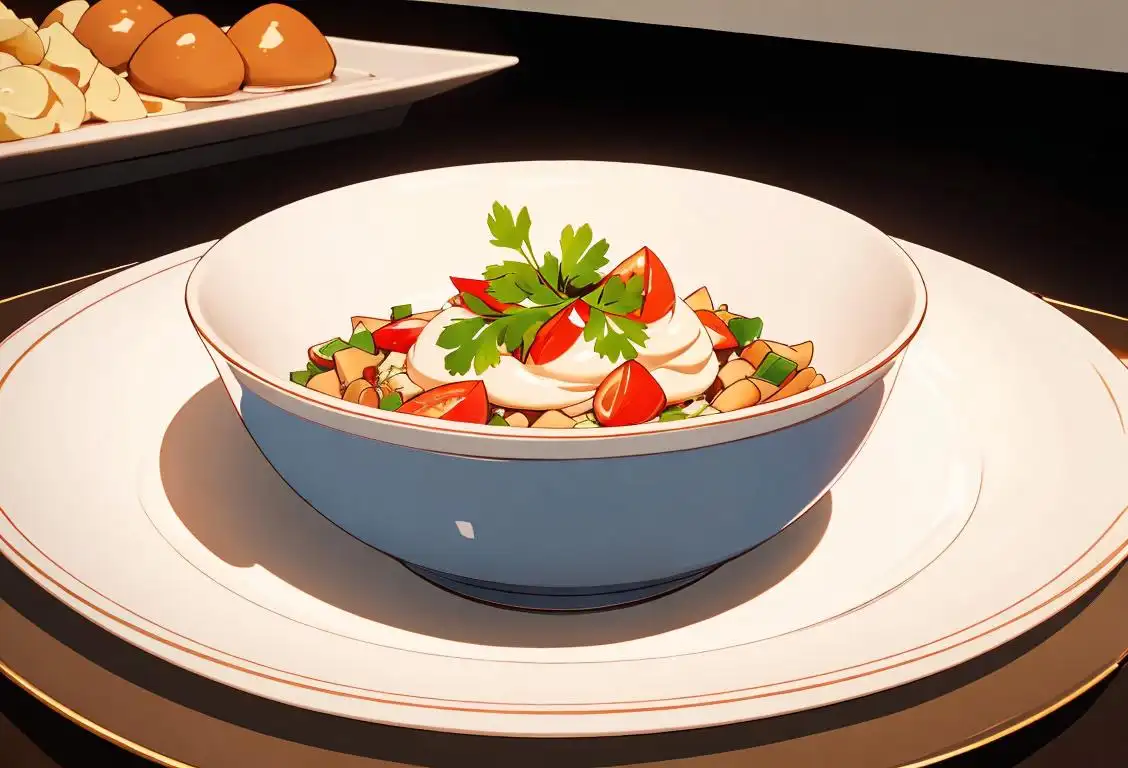National Souffle Day

Hey there, souffle enthusiasts! Get ready to rise to the occasion because it's National Souffle Day! Today, we celebrate the delicate and fluffy wonder that is the souffle. So, grab your whisk and apron, and let's dive into the delicious world of souffles!
When is Souffle Day?
It's national souffle day on the 28th February.
The Delightful Rise of Souffles
Imagine a heavenly creation, a gentle touch of air, and a burst of flavors dancing on your taste buds. That, my friends, is the magical experience of enjoying a souffle. This oh-so-French delicacy has been delighting foodies around the world for centuries.
The history of the souffle takes us back to 18th-century France, where it gained popularity in the culinary courts of King Louis XV. The word 'souffle' itself means 'to puff' or 'to breathe,' perfectly describing the nature of this delicate dish.
A souffle starts with a humble base, typically made with egg yolks, flour, butter, and a flavorful ingredient like chocolate, cheese, or fruits. But here comes the exciting part—the whisking of egg whites! These whites are beaten to peak stiffness, creating tiny air bubbles that give the souffle its signature rise. Remember, we're talking about a rise like a happy sunflower reaching for the sky, not some dodgy souffle tax scheme!
Once baked in the oven, the souffle emerges as a fluffy, golden masterpiece. It's a work of art that can be both sweet or savory, depending on your culinary desires. Whether you're indulging in a decadent chocolate souffle or relishing the cheesy goodness of a gruyere souffle, each bite is a taste of pure joy.
History behind the term 'Souffle'
1742
First recorded use of the term souffle
The term 'souffle' was first recorded in 1742 by French chef, Vincent La Chapelle, in his cookbook 'Le Cuisinier Moderne'. Souffle, which means 'puffed up' or 'blown,' referred to a dish that is made with beaten egg whites and baked to create a light and airy texture.
18th century
The Rise of the Souffle
The term 'souffle' originated in the 18th century in France. It comes from the French verb 'souffler,' which means 'to puff' or 'to blow.' The word 'souffle' appropriately describes the light and airy texture of this delicate dish.
18th Century
Birth of the Souffle
The term 'souffle' originated in the 18th century in France. It comes from the past participle form of the French verb 'souffler,' which means 'to puff' or 'to blow.' This term was initially used to describe a light and fluffy egg-based dish that rose as it cooked in the oven. The souffle quickly became popular among the French aristocracy for its delicate and airy texture.
19th century
Marie-Antoine Carême: The Souffle Master
In the 19th century, the art of making souffles reached new heights thanks to the renowned French chef Marie-Antoine Carême. Carême was known for his contributions to French cuisine, and he elevated the souffle to a culinary masterpiece. His expertise and innovative techniques made souffles incredibly popular among the upper class.
19th Century
Souffle's Rise to Fame
During the 19th century, the souffle gained immense popularity and became a staple in French cuisine. Chefs started experimenting with various flavors and ingredients, expanding the repertoire of souffle recipes. The airy concoction became synonymous with elegance and fine dining, gracing the tables of prestigious restaurants and royal households.
18th Century
Rise in popularity of souffles in French cuisine
During the 18th century, souffles gained popularity in French cuisine. The delicate and impressive nature of these dishes, with their ability to rise and puff up dramatically, made them a favorite among both the aristocracy and the bourgeoisie. Chefs started experimenting with various flavors and ingredients to create both sweet and savory souffles.
20th century
Souffle Goes Global
During the 20th century, souffles started to gain worldwide recognition. As French cuisine spread, so did the popularity of this delightful dish. Chefs from different countries started experimenting with new flavors and variations, creating savory and sweet souffles that catered to diverse tastes.
20th Century
The Souffle Spreads Globally
In the 20th century, the art of making souffles spread beyond France and gained international recognition. Renowned chefs and culinary enthusiasts from different countries embraced the souffle, introducing their own variations and interpretations. The dish began to grace the menus of fine dining establishments worldwide, captivating the taste buds of people from diverse cultures.
19th Century
Incorporation of souffles in French fine dining
In the 19th century, souffles became a staple in fine dining establishments across France. Renowned chefs, such as Antonin Carême and Auguste Escoffier, perfected the techniques and presentation of souffles, elevating them to an art form. Served as a main course or dessert, souffles became a symbol of elegance and sophistication.
Present Day
Souffle's Enduring Appeal
Today, the souffle remains a symbol of culinary mastery and sophistication. It has become a classic favorite among food enthusiasts, with both sweet and savory versions captivating palates. Despite its delicate nature and the challenge of achieving the perfect rise, the allure of a well-executed souffle continues to captivate diners in the quest for an unforgettable dining experience.
21st century
Souffle Reinvented
In the 21st century, chefs continued to push the boundaries of traditional souffles, experimenting with unconventional ingredients and presentation styles. Souffle became not only a classic French dessert but also an inventive culinary creation that allowed for endless creative possibilities. Today, you can find souffles with unique flavors and textures in restaurants around the world.
20th Century
International popularity and variations of souffles
During the 20th century, the art of souffle-making spread globally, gaining popularity in countries such as the United States and England. Chefs and home cooks experimented with a wide range of ingredients, including cheese, chocolate, fruits, and vegetables, creating diverse and delightful souffle variations to suit different tastes.
Present Day
Continued appreciation and reinterpretation of souffles
Today, souffles continue to be celebrated for their delicate texture and impressive rise. Experienced chefs use modern techniques and ingredients to push the boundaries of traditional souffles, creating innovative flavor combinations and artistic presentations. Souffles are still enjoyed as a luxurious treat, often reserved for special occasions or as a signature dish in fine dining establishments.
Did you know?
Did you know that souffles were once considered a fashionable dish served at 18th-century French royal courts? It was believed to be the epitome of elegance and sophistication, much like a classy top hat or a monocle-wearing poodle!Tagged
romance food funFirst identified
18th May 2016Most mentioned on
28th February 2017Total mentions
53Other days
One Day
Family Day
Action Day
Kissing Fried Chicken Day
Vodka Boyfriend Day
Awareness Day
Opposite Day
Suicide Prevention Month Day
Happiness Day
Nutty Fudge Day









